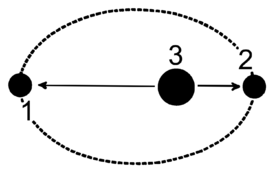Tags | |
The Apsis-Pericenter Maximum Speed calculator computes the maximum speed in an orbit at perigee based on the semi-major axis (a), eccentricity (e), the mass of the primary body (M), and the Universal Gravitational Constant (G).
INSTRUCTION: Choose units and enter the following:
- (M) This is the mass of the primary body.
- (a) This is the semi-major axis of the orbit
- (e) This is the eccentricity of the the orbit
Maximum Orbital Speed(Vper): The calculator returns the velocity in meters per second. However this can be automatically converted to compatible units via the pull-down menu.
Related Calculators
- Force of Gravity computes the force of gravity between two bodies.
- Apsis-Apocenter (minimum speed) computes the minimum velocity at the maximum distance of an orbit.
- Apsis-Apocenter (maximum distance) computes the greatest distance from the center of gravity in an orbit.

The apsides indicate the nearest
and furthest points of an
orbiting body around its host.
(1) farthest - apocenter
(2) nearest - pericenter
(3) focus - primary - Apsis-Pericenter (maximum speed) computes maximum velocity at the minimum distance of an orbit.
- Apsis-Pericenter (minimum distance) computes the minimum distance from the center of mass in an orbit.
- Standard Gravitational Parameter
The Math / Science
The Apsis-Pericenter (maximum speed) is an extreme point in an object's orbit. For elliptical orbits about a larger body, there are two apsides. The Pericenter is the point closest to the object being orbited.
The formula for the Apsis-Pericenter maximum speed is:
`v_(per) = sqrt ( ((1+e)mu)/((1-e)a) ) `
where:
- vper is velocity at perigee
- e = eccentricity
- a = semi-major axis
- μ = standard gravitational parameter (μ = M•G)
References
Wikipedia (https://en.wikipedia.org/wiki/Apsis)

